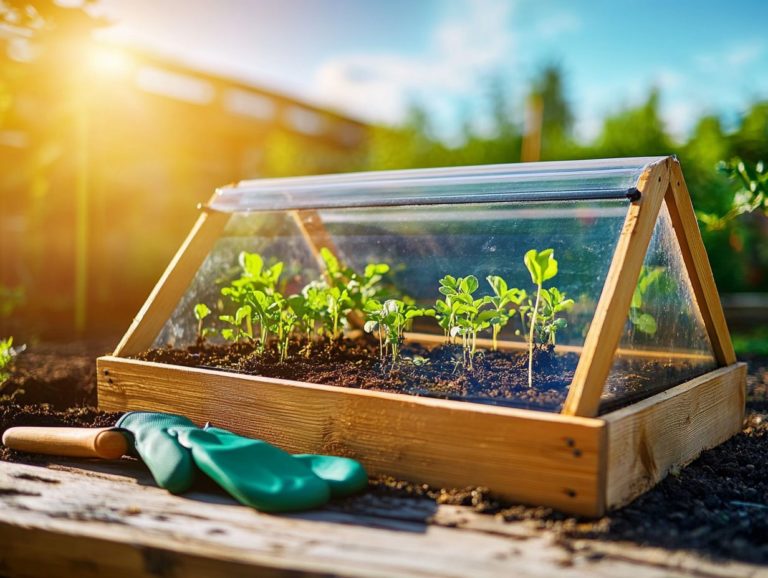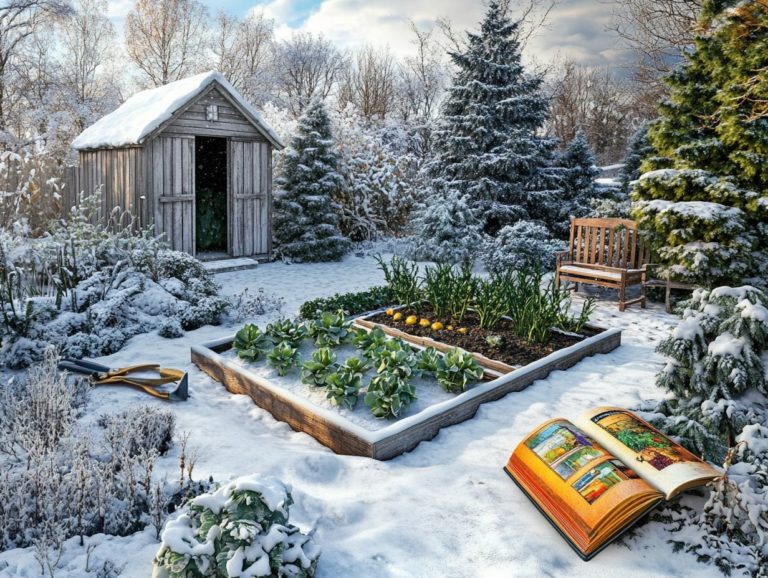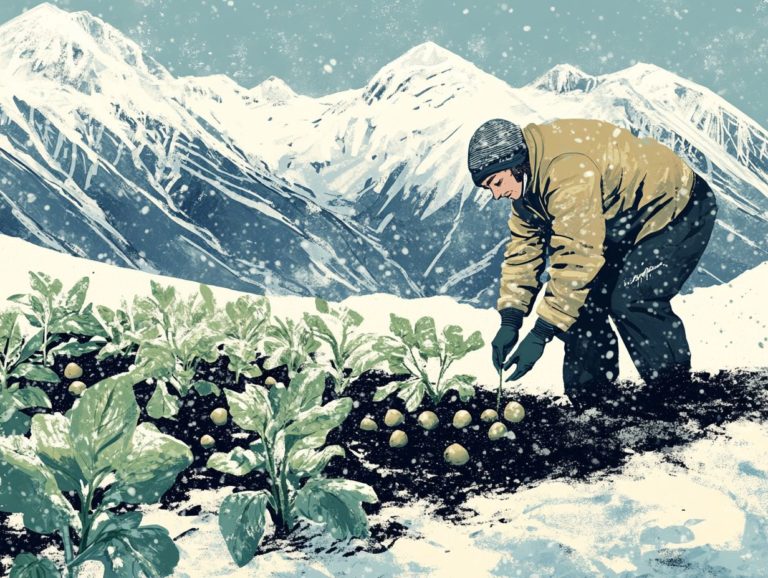How to Select Cold-Hardy Plants for Your Garden?
Cold-hardy plants are your ultimate allies when navigating the challenges of gardening in less-than-ideal climates.
These strong varieties not only endure frigid temperatures but also add beauty and functionality to your outdoor spaces.
This article delves into what makes cold-hardy plants special, highlighting key factors you should consider when selecting them, along with some popular varieties that can elevate your garden. Get ready to transform your garden into a stunning winter wonderland with plants that thrive in the cold!
Contents
Key Takeaways:
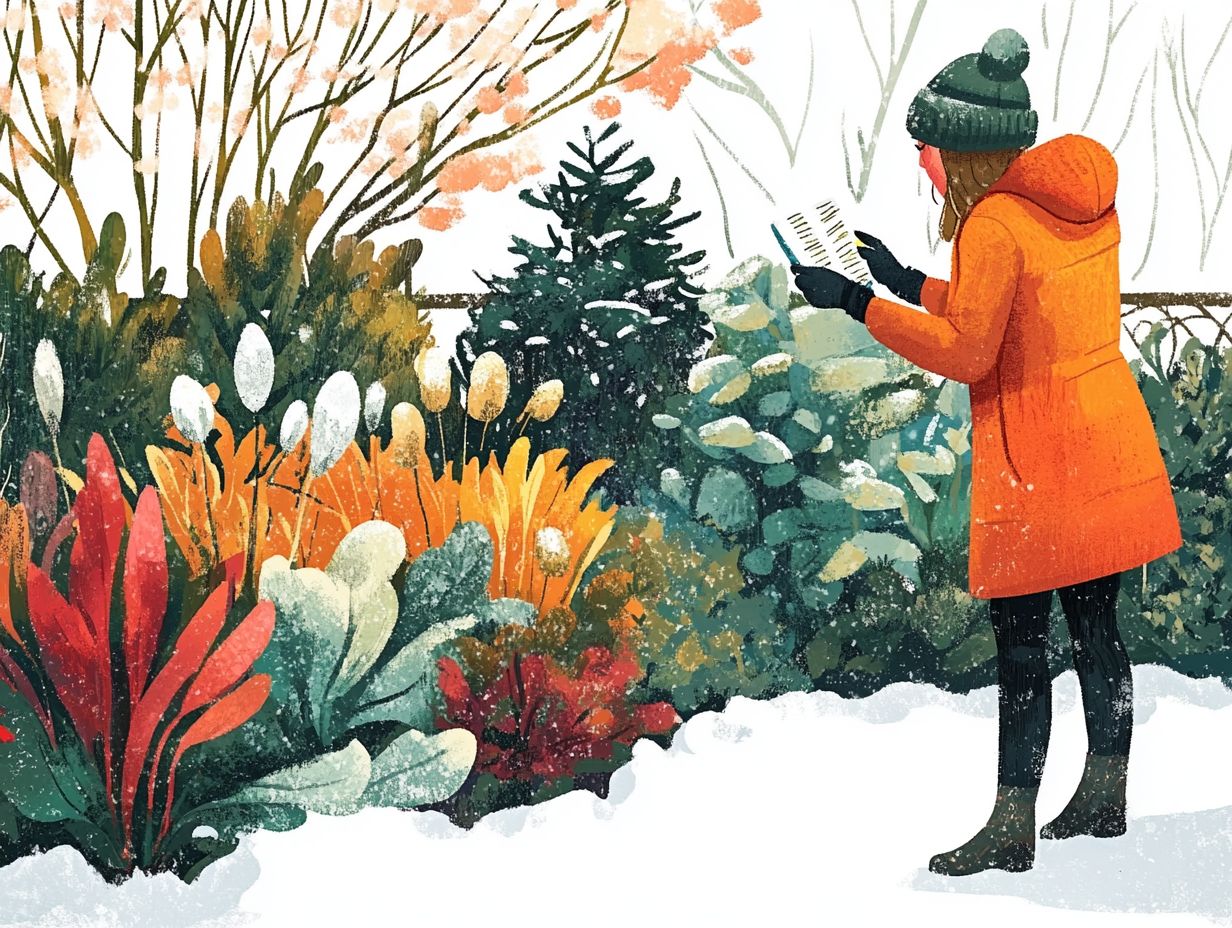
- Choose plants suitable for your climate and hardiness zone to ensure survival in cold temperatures.
- Consider factors such as sunlight, soil, and plant size when selecting cold-hardy plants for your garden.
- Protect and care for cold-hardy plants by using strategies such as mulching, watering, and addressing pests and diseases.
Understanding Cold-Hardy Plants
Understanding cold-hardy plants is essential for any gardening enthusiast who aims to cultivate a vibrant garden capable of enduring the challenges of winter. For insights on selecting plants for a winter garden, these remarkable plants are not just strong to frigid temperatures; they also contribute significantly to plant health and foster wildlife interactions within diverse ecosystems.
By gaining a thorough understanding of your local climate, available gardening resources, and USDA hardiness zones, which classify plants based on their ability to survive winter temperatures, you can expertly select plants for frost-prone areas that will thrive even under harsh conditions. This knowledge gives you the power to make informed decisions about plant selection, leading to a landscape design that flourishes throughout the year.
What are Cold-Hardy Plants?
Cold-hardy plants are your go-to species, perfectly adapted to thrive in regions that endure harsh winter conditions, complete with frigid temperatures and dates of frost. For those interested in landscaping, understanding plant selection for cold-climate design is crucial.
These remarkable plants showcase a range of characteristics that allow them to flourish despite extreme climatic challenges. For example, they often boast a robust root system that enables them to tap into moisture lurking beneath the frozen ground. Many of them have also developed thick, waxy leaves or protective bark to shield themselves from icy winds and relentless sun exposure.
Cold-hardy varieties are classified into specific USDA hardiness zones. These zones provide valuable insight into which plants can withstand your local climate. By selecting plants for cold-climate rain gardens, you can opt for these strong species that not only elevate your garden’s aesthetics but also reduce maintenance demands, ensuring your landscape remains vibrant and beautiful throughout the year.
Factors to Consider when Choosing Cold-Hardy Plants
Selecting the right cold-hardy plants demands your careful attention to several key factors. For the best results, be sure to check out the top 5 tips for selecting cold-hardy plants, which emphasize the importance of considering the local climate, soil quality, sunlight exposure, and water availability.
By taking these elements into account, you can ensure that your garden flourishes beautifully throughout the growing seasons.
Climate and Hardiness Zones
Understanding climate and hardiness zones is essential for you to select plants that will thrive in your local environment. These zones provide crucial insights into temperature variations and plant resilience.
By familiarizing yourself with USDA hardiness zones, you can gauge the specific climatic conditions of your area, such as average winter lows, which directly affect plant survival. These zones serve as a valuable guide for selecting cold-hardy species that can endure harsh winters without succumbing to frost damage.
Grasping these temperature fluctuations gives you the power to cultivate a flourishing garden, ensuring the plants you choose can withstand the unique challenges posed by your climate. By making informed selections based on this vital climatic information, you can maximize your chances of success and longevity in your horticultural endeavors.
Soil and Sunlight Requirements

The soil and sunlight requirements of cold-hardy plants are essential for their success and longevity in your garden. You’ll need to carefully assess soil quality and how well the soil lets water through, as well as ensure they receive adequate sunlight exposure.
To create the ideal environment for these resilient species, start with a soil test. This means collecting samples from various spots in your garden to gauge pH levels and nutrients in the soil, both vital for healthy growth.
After the analysis, improving soil quality can often be achieved by adding organic matter, like compost or well-rotted manure. This not only enriches the soil but also boosts its drainage.
Cold-hardy plants generally thrive in well-draining soils that receive full to partial sunlight, so it’s crucial to pay attention to the specific sunlight needs indicated on seed packets or plant tags. This will ensure your plants establish themselves successfully.
Plant Size and Growth Habits
When selecting cold-hardy plants, it’s essential to consider their size and growth habits. For more detailed guidance, check out this resource on how to start a cold-climate garden. This ensures they harmonize beautifully within your garden’s landscape design and cater to your gardening aspirations.
Understanding the mature height and spread of these plants helps you decide how far apart to plant them. This allows you to create vibrant arrangements that prevent overcrowding and nutrient competition.
Adequate spacing becomes even more critical in container gardening, where limited root space can stifle growth. By incorporating plants with diverse growth habits be it upright, sprawling, or bushy you can add visual intrigue and foster healthier ecosystems.
Thoughtful planning guarantees that each plant thrives, enhancing both the aesthetic appeal and functional diversity of your garden while making maintenance a breeze for everyone who enjoys the space.
Common Cold-Hardy Plant Varieties
You’ll discover a remarkable array of cold-hardy plants, encompassing trees, shrubs, perennials, and annuals, all perfectly equipped to thrive in colder climates. For more information, check out selecting plants for cold climate community gardens. These resilient botanicals not only endure the chill but also enrich your garden ecosystem with their vibrant presence.
Trees and Shrubs
Cold-hardy trees and shrubs do more than just beautify your landscape; they enhance plant health and foster wildlife interaction within your garden.
Take the robust Eastern Red Cedar and the vibrant Winterberry Holly, for instance. These hardy varieties not only brave the harsh winters but also provide essential habitats for local birds and beneficial insects.
The Red Osier Dogwood, with its striking red stems in winter, offers berries that attract various species, encouraging a rich biodiversity.
By incorporating these resilient plants into your garden, you can create layers of texture and color that elevate visual interest throughout the year. Strategically placing these species can develop windbreaks, mitigate soil erosion, and supply crucial food sources for wildlife during the colder months, making them invaluable assets for any thoughtful gardener.
Perennials and Annuals
Cold-hardy perennials and annuals will transform your garden into a canvas of color and vibrancy, enhancing your growing seasons while providing you with low-maintenance options.
These hardy plants love a challenge and thrive in tough climates, often flourishing through late frosts, making them perfect for extending your gardening season.
Varieties like pansies and snapdragons deliver vibrant blooms in early spring, while perennials such as coneflowers and daylilies maintain stunning colors throughout the summer and into the fall.
Caring for these beauties is generally a breeze, requiring only occasional deadheading and mulching to retain moisture and keep those pesky weeds at bay.
By incorporating these flower varieties, you can elevate your outdoor aesthetics, crafting a captivating landscape that not only delights the eye but also supports local pollinators and wildlife.
Start your garden transformation now with these stunning cold-hardy plants!
Strategies for Protecting Cold-Hardy Plants

Protecting your cold-hardy plants is essential for their survival. Use a comprehensive approach that includes:
- Covering them
- Applying mulch
- Ensuring proper watering
- Providing the right fertilization
Each of these methods is important for their ongoing health and helps create an environment where they can thrive in colder climates.
Covering and Mulching
Covering and mulching are fantastic ways to protect your plants this winter! These methods protect your plants from cold winds and frost. They also improve the health of the soil.
By using organic materials like straw, wood chips, or shredded leaves, you can create a beneficial microclimate that insulates the roots and encourages beneficial microbial activity. These layers help prevent erosion and leaching, making sure nutrients remain accessible for your plants.
When applied strategically, mulching acts as a barrier that regulates soil temperature. This further boosts the vitality of your cold-hardy plants as they weather the harsh winter months.
Keep Your Plants Hydrated and Fed!
Proper watering and fertilizing are vital to maintaining the health of your cold-hardy plants. These practices ensure they thrive and stand strong against environmental challenges.
Understand the unique water needs of these plants, especially during their active growing season when they require more moisture. Finding the right balance is crucial; overwatering can lead to root rot, while underwatering might stunt their growth.
Incorporating organic matter, like compost or well-rotted manure, can greatly enhance soil structure. This makes it better at retaining moisture and nutrients. Regularly testing your soil s pH a measure of how acidic or basic your soil is will help you adjust fertilizers as needed, ensuring your plants flourish in their environment and endure harsh conditions for the long haul.
Maintaining and Caring for Cold-Hardy Plants
To maintain and care for your cold-hardy plants, embrace a series of essential practices. Regular maintenance, effective pruning techniques, and a holistic approach to pest management will help ensure these resilient beauties thrive throughout the year.
Pruning and Trimming
Pruning and trimming are essential for ensuring the health and growth of your cold-hardy plants. These practices allow them to bask in better air circulation and sunlight exposure.
These techniques promote vigorous growth and serve as a barrier against disease and pest infestations. By removing dead or damaged branches, you can stimulate new growth and encourage a strong structure. Timing is everything; late winter or early spring often provides the perfect window, preparing your plants for optimal health as the growing season approaches.
Using specific techniques like heading cuts or thinning cuts can enhance the plant’s aesthetic appeal while ensuring efficient nutrient distribution throughout. This meticulous attention to detail ultimately cultivates a thriving garden that can withstand even the harshest temperatures.
Dealing with Pests and Diseases
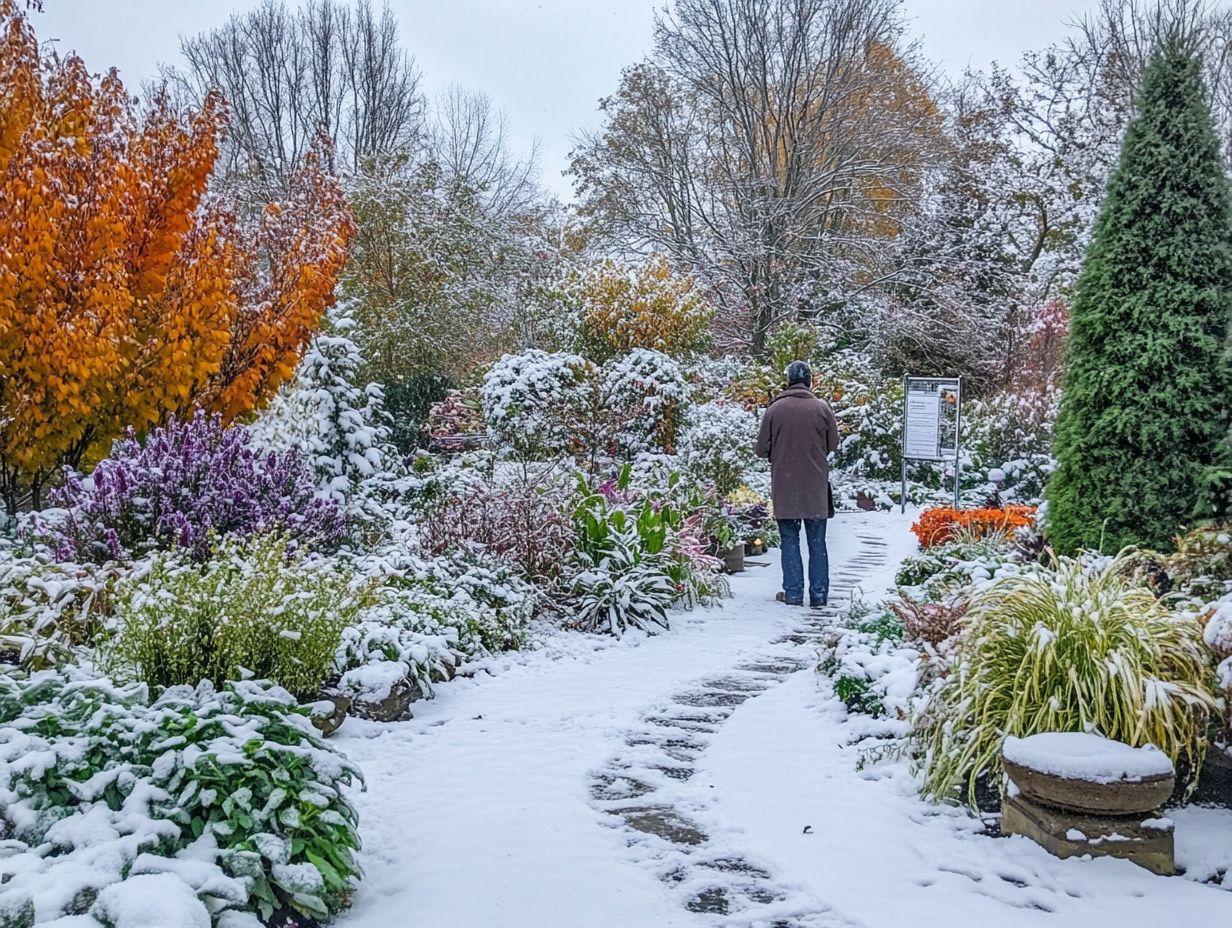
Managing pests and diseases is essential for keeping your cold-hardy plants healthy. A complete pest management approach will help protect them.
Understanding the needs of these tough plants is important. This knowledge helps you use natural and simple methods to protect them.
By emphasizing preventive measures like crop rotation and companion planting, you can significantly enhance your garden’s resilience against common threats.
Using natural deterrents like neem oil or insecticidal soap protects your plants while keeping helpful insects and the environment safe. Regular monitoring of your plants will help you spot problems early. This way, you can keep them healthy and thriving!
Frequently Asked Questions
What does it mean for a plant to be cold-hardy?
Cold-hardy plants can survive and thrive even when temperatures drop below freezing.
Why should I choose cold-hardy plants for my garden?
Cold-hardy plants will survive winter and bloom beautifully in spring, saving you the hassle of replanting.
What common traits do cold-hardy plants have?
These plants often have smaller leaves, thicker stems, and can handle frost and snow better.
How do I find out which plants are cold-hardy?
Check your area’s hardiness zone or talk to a local gardening expert for the best plant choices.
Can I have a diverse garden with cold-hardy plants?
Definitely! There are many types of cold-hardy plants, from colorful flowers to sturdy trees and shrubs.
What are some popular cold-hardy plants?
Popular choices include conifers, holly bushes, winterberry, pansies, and cabbage.

